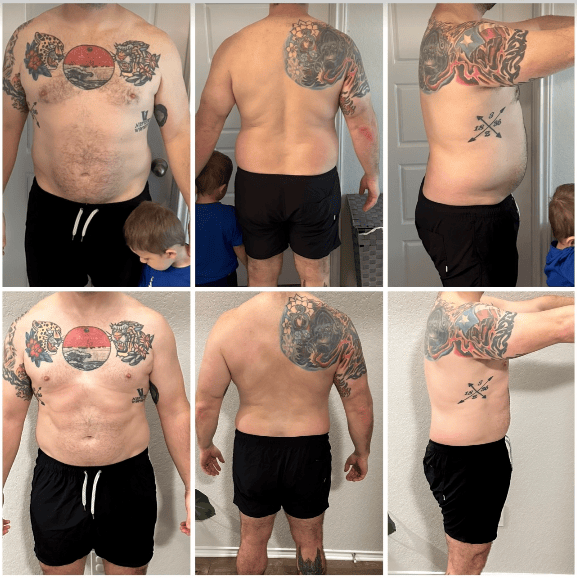What's up Fit Fam!
We all know the old saying for losing weight, move more and eat less. But, on the flip side, to gain muscle, you're told to eat more… super helpful, right?
That's why today we are going to be talking about calories in versus calories out and how to truly understand what that means for reaching your goals.
Keep in mind calories in versus calories out is the most important factor overall, but at the same time, it's just the beginning of the equation!
My name is Chad, and I'm the sports performance nutrition coach at our Houston Location.
What does calories in versus calories out mean?
Simply put, the number of calories you eat will either be more or less than the amount of energy you burn daily.
I've been doing this long enough to know if I put a client in a deficit, they will lose weight, and if I put them in a surplus, they will gain. Notice I said WEIGHT. You will lose or gain, but what makes up this weight?
That all depends on WHAT you're fueling your body with and HOW you're moving your body daily. For example, you will lose muscle mass if you are in a calorie deficit without a daily protein goal. On the flip side, if you eat in a surplus but do not track fats, you are more likely to overshoot your calories and gain unnecessary body fat.
That doesn't mean fats are bad. Fats are actually essential for survival just like proteins and carbs, BUT it's important to know that fat is the most costly macronutrient; 1 gram of fat costs 9 calories, where 1 gram of protein or carbs costs only 4 calories. In other words, fats are double the amount of calories than protein and carbs.
Now with that knowledge, you can better understand why I say a calorie is not necessarily just a calorie. Without the corresponding macros that make them up, we could be talking about anything.
I know I am not the only one who has had that morning donut or two… with fancy coffee. With two donuts, you are easily eating 400 calories. But let me challenge you with this thought. Our average regular-size meal at My Fit Foods is 400 calories. How do you feel after eating one of our breakfasts versus those donuts?
Of course, those donuts are going to give you instant gratification, but they will leave you feeling hungry, tired, and unsatisfied within the next hour. Not to mention you are going to be battling cravings all day long and reaching for that 2 PM pick me up.
With a balanced My Fit Foods breakfast, I can guarantee you will have longer, more sustained energy, fewer cravings, and feel WAY more satisfied with the amount of food you were able to eat while staying on target for your goals.
Whenever we have a calorie window to stay within, the game becomes how much food can I fit into this window without going over. This is where a food's nutrient density gives meaning to its calories.
When we compare food volume or the amount of food, to the amount of calories, in this case, one regular MFF meal to two donuts, the volume between the two will be drastically different. We can all agree that eating an MFF meal of 13oz is going to be WAY more filling than eating 4 oz. of donuts, even if they are the same amount of calories. Nutrition density is what explains the massive difference between these two foods. Because of the balance of macros in our MFF versus that of a donut, we are able to get 3x the volume of food into that 400 calories than we can the donuts.
And for those of you who already know that donuts don't compare to a balanced meal, think about your healthy afternoon snack of an apple and spoon full of peanut butter (for that protein). Are we considering if the grams of protein outweigh the grams of sugars and fats? With peanut butter, I can tell you it does not.
We, as humans, are exactly the same! So telling me just your weight doesn't really tell much. There are specifics about you that make up that weight, like muscle mass, body fat, your organs, and everything inside you.
So when I meet with a client, and we set up their calorie window, I look at their whole body composition because the macros that make up their calories are just as important as the calorie window itself.
Making sure you hit your macros, not just calories is how you move from losing or gaining weight to recomping and controlling the shift of your body composition.
For the weight-loss client, that means we are feeding your body the right amount of protein to ensure you are preserving, if not growing, your muscle while in a deficit.
For my gainers, making sure you are eating balanced, healthy meals (aka My Fit Foods), we can avoid adding extra body fat while you are in a surplus.
At My Fit Foods, we formulate our meals to emphasize volume while prioritizing high protein with a balance of carbs and fats to ensure we can fit as much delicious food into that calorie window as possible. This is the best approach to keep you full, energized and happy as you attack your goals.
So when it comes to calories in versus calories out, the big take home message here is not about limiting the amount of food to stay within your calories, it's about finding the right foods to get more bites out of each meal. Happy eating!
Thanks, Fit Fam, see you soon!
About Author: Mario Mendias







